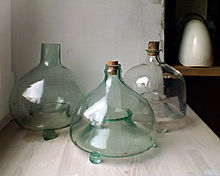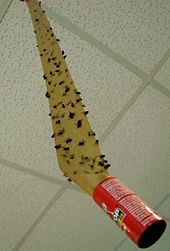Fly-killing device
A flyswatter (or fly-swat, fly swatter[1]) usually consists of a small rectangular or round sheet of a lightweight, flexible, vented material (usually thin metallic, rubber, or plastic mesh) around 10 cm (4 in) across, attached to a handle about 30 to 60 cm (1 to 2 ft) long made of a lightweight material such as wire, wood, plastic, or metal.The abeyance of insects by use of short horsetail staffs and fans is an ancient practice, dating back to the Egyptian pharaohs.[citation needed][disputed – discuss] The earliest flyswatters were in fact nothing more than some sort of striking surface attached to the end of a long stick.[citation needed] Another gun-like design consists of a pair of mesh sheets spring loaded to "clap" together when a trigger is pulled, squashing the fly between them.[11] Arsenic extracted by soaking flypaper in water has been used by several convicted murderers, among them Lyda Southard, Frederick Seddon, Florence Maybrick,[12] and the Angel Makers of Nagyrév.[15] A related device powered by mouth suction is called a pooter, and is used by entomologists and students to capture small organisms for study.[16][17] This design uses a continuously running electric fan to suck in flying insects (especially mosquitos and gnats, which are weak fliers), which are then trapped by a fine mesh grid or bag.[18][19] Other designs rely on the natural carbon dioxide or scents emitted by people, pets, or livestock to attract pests, and simply collect flying insects as they wander close enough to be sucked in.[20][18] In addition, the continuous breeze produced by a common electric fan has been found to discourage mosquitos from landing and biting, even without trapping or killing the insects.Bug zappers are generally small appliances intended for use in a fixed location, as distinguished from hand held electric flyswatters.In some swatters, an inner expanded metal or wire grid mesh is sandwiched between two outer arrays of rods, designed so that fingers are not able to poke through and bridge the electrodes, while small insects can.




Flyswatter (song)demo albumBlink-182 (album)pest controlhousefliesmosquitoesair resistanceaccelerationreaction timehorsetailRobert R. MontgomeryDr. Samuel CrumbineTopekasoftballyardsticknovelty itemsCentral Europephototaxisarsenicmercury chlorideMediterranean fruit flyolive flydishwashing detergentinsectsFederal Insecticide, Fungicide, and Rodenticide ActhumansLyda SouthardFrederick SeddonFlorence MaybrickAngel Makers of Nagyrévinsecticidesbug zappersaspiratordehydratesentomologistscarbon dioxideultraviolet lightBug zapperelectrocutionhigh voltagetennis racketJoule thiefcapacitorexpanded metalmicrocoulombsnanofaradsmilliamperesFly-whiskFly sprayMosquito controlVenus flytrapSundew plantPitcher plantCarnivorous plantYouTube